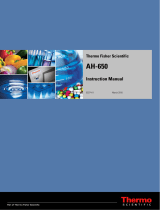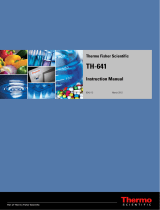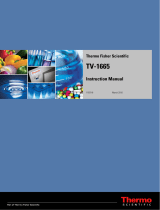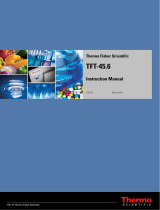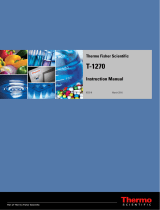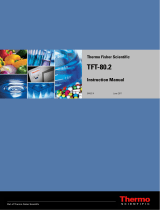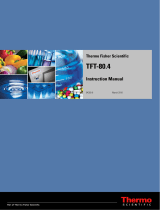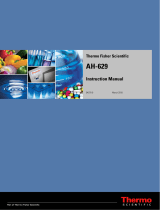Page is loading ...

79231-9 March 2010
Thermo Fisher Scientific
STEPSAVER
Instruction Manual

© 2009 Thermo Fisher Scientific Inc. All rights reserved.
ULTRACRIMP is either a registered trademark or a trademark of Thermo Fisher Scientific.
All other trademarks are the property of Thermo Fisher Scientific Inc. and its subsidiaries.
Thermo Fisher Scientific Inc. provides this document to its customers with a product purchase to use in the
product operation. This document is copyright protected and any reproduction of the whole or any part of this
document is strictly prohibited, except with the written authorization of Thermo Fisher Scientific Inc.
The contents of this document are subject to change without notice. All technical information in this
document is for reference purposes only. System configurations and specifications in this document supersede
all previous information received by the purchaser.
Thermo Fisher Scientific Inc. makes no representations that this document is complete, accurate or error-
free and assumes no responsibility and will not be liable for any errors, omissions, damage or loss that might
result from any use of this document, even if the information in the document is followed properly.
This document is not part of any sales contract between Thermo Fisher Scientific Inc. and a purchaser. This
document shall in no way govern or modify any Terms and Conditions of Sale, which Terms and Conditions of
Sale shall govern all conflicting information between the two documents.
Release history: 79231-9 printed in March 2010.
For Research Use Only. Not for use in diagnostic procedures.

Thermo Scientific STEPSAVER i
T
Thermo Scientific STEPSAVER™ Rotor Systems ............................................................... ii
Important Safety Information ................................................................................................. iii
Chapter 1 DESCRIPTION ......................................................................................................................... 1-1
Rotor and Cartridge Description ............................................................................. 1-2
Rotor Application .................................................................................................... 1-2
Rotor Specifications ................................................................................................. 1-2
Rotor Systems and Accessories ................................................................................. 1-3
Chapter 2 RUN PREPARATION ............................................................................................................... 2-1
Prerun Safety Checks ............................................................................................... 2-2
Rotor Precool .......................................................................................................... 2-3
Chemical Compatibility .......................................................................................... 2-3
Sample Preparation .................................................................................................. 2-3
Chapter 3 SPECIAL OPERATING CONSIDERATIONS ......................................................................... 3-1
Compartment Loads in Excess of Design Mass ........................................................ 3-2
Precautions to Prevent Precipitation of Cesium Chloride ......................................... 3-3
Critical Speed .......................................................................................................... 3-4
Chapter 4 OPERATION ............................................................................................................................. 4-1
Rotor Balancing ....................................................................................................... 4-2
Rotor Loading ......................................................................................................... 4-3
Rotor Installation ..................................................................................................... 4-4
Acceleration and Deceleration .................................................................................. 4-4
Tube Removal ......................................................................................................... 4-5
Centrifuge/Rotor Log Book ..................................................................................... 4-5
Chapter 5 TECHNICAL NOTES ................................................................................................................ 5-1
Relative Centrifugal Force (RCF) Determination .................................................... 5-2
Calculation of Sedimentation Time in Aqueous (Non-gradient) Solutions .............. 5-3
Calculation of Sedimentation Time in Gradient Solutions ...................................... 5-4
Chapter 6 CARE and MAINTENANCE .................................................................................................. 6-1
Corrosion ................................................................................................................ 6-2
Cleaning and Decontamination ............................................................................... 6-2
Overspeed Decal Replacement ................................................................................. 6-3
Storage ..................................................................................................................... 6-4
Inspection ................................................................................................................ 6-4
Service Decontamination Policy .............................................................................. 6-4
Chemical Compatibility Chart ...............................................................................A-1
Contact Information ................................................................................................B-1
Table of contents


Thermo Scientific STEPSAVER ii
P
This manual is a guide for use of the
Thermo Scientific STEPSAVER™ Rotor Systems
Data herein has been verified and is believed adequate for the intended use of the rotor. Because failure
to follow the recommendations set forth in this manual could produce personal injury or property
damage, always follow the recommendations set forth herein. Thermo Fisher Scientific does not
guarantee results and assumes no obligation for the performance of rotors or other products that are
not used in accordance with the instructions provided. This publication is not a license to operate
under, nor a recommendation to infringe upon, any process patents.
Publications prior to the Issue Date of this manual may contain data in apparent conflict with that
provided herein. Please consider all data in this manual to be the most current.
WARNING, CAUTION, and NOTE within the text of this manual are used to emphasize important
and critical instructions.
WARNING informs the operator of a hazard or an unsafe practice that could result in personal injury,
affect the operator's health, or contaminate the environment.
CAUTION informs the operator of an unsafe practice that could result in damage of equipment.
NOTE highlights essential information.
© 1998, 1999, 2008, 2010 by Thermo Fisher Scientific
CAUTION and WARNING are accompanied by a hazard symbol and appear near the
information they correspond to.

Preface
iii STEPSAVER Thermo Scientific
Important Safety Information
Certain potentially dangerous conditions are inherent to the use of all centrifuge rotors. To ensure safe
operation of this rotor, anyone using it should be aware of all safe practices and take all precautions
described below and throughout this manual..
WARNING
When using radioactive, toxic, or pathogenic materials, be aware of all characteristics of
the materials and the hazards associated with them in the event leakage occurs during
centrifugation. In the event of a rotor failure, neither the centrifuge nor the rotor can
protect you from particles dispersed in the air. To protect yourself, we recommend
additional precautions be taken to prevent exposure to these materials, for example, use of
controlled ventilation or isolation areas.
Always be aware of the possibility of contamination when using radioactive, toxic, or
pathogenic materials. Take all necessary precautions and use appropriate decontamination
procedures if exposure occurs.
Never use any material capable of producing flammable or explosive vapors or creating
extreme exothermic reactions.
Never exceed the maximum rated speed of the installed rotor; to do so can cause rotor
failure.
Always reduce (derate) rotor speed as instructed in this manual whenever:
•the rotor speed/temperature combination exceeds the solubility of the gradient
material and causes it to precipitate. See page 3-2.
•the compartment load exceeds the maximum allowable compartment load specified
(average fluid density greater than 1.7 g/ml). See page 3-1.
Failure to reduce rotor speed under these conditions can cause rotor failure.
CAUTION
Do not operate or precool the rotor at the critical speed, as this will have a detrimental
effect on centrifuge component life. See page 3-3.
Do not operate the rotor unless it is symmetrically balanced as described in this manual.
Operating the rotor out of balance can cause damage to the centrifuge drive assembly.
Always maintain the rotor in the recommended manner. The rotor and all accessories
must be clean and inspected prior to each run: do not use rotors showing signs of
corrosion or cracking. See Chapter 6, Care and Maintenance.

Thermo Scientific STEPSAVER 1-1
1
DESCRIPTION
This manual contains information required to operate and maintain the Thermo Scientific
STEPSAVER ™ Rotor Systems. If you require additional information regarding operation or
maintenance, please contact Thermo Fisher Scientific for assistance. In the United States, call Thermo
Fisher Scientific toll-free 1-866-9THERMO; outside the United States, contact the nearest Thermo
Fisher Scientific office (see back cover) or your local representative for Thermo Fisher Scientific
products. Thermo Fisher Scientific product information is available on our internet web site at
http://www.Thermo.com .
Contents
•“Rotor and Cartridge Description” on page 1-2
•“Rotor Application” on page 1-2
•“Rotor Specifications” on page 1-2
•“Rotor Systems and Accessories” on page 1-3

1 DESCRIPTION
Rotor and Cartridge Description
1-2 STEPSAVER Thermo Scientific
Rotor and Cartridge Description
The STEPSAVER ™ Rotors are machined from a titanium forging for strength and corrosion
resistance. The through holes of these rotors are bored parallel to the rotor axis. Each rotor is painted
military blue. This painted coating provides surface protection and aids temperature regulation. A
disc with alternating black and reflective segments is attached to the bottom of the rotor which
prevents the rotor from being operated above its recommended maximum speed.
The tube cartridge sets1 are made from an engineered plastic material. The tube cartridges streamline
sample loading reducing the chance of sample loss and are color-coded for easy matching with the
sample tube being used. A wide selection of cartridge sets are available for each rotor that enable
various tube volumes to be processed.
Rotor Application
The STEPSAVER ™ Rotor Systems are used in an ultracentrifuge, primarily for density gradient
separations (the design of the vertical rotor allows these separations to be done in shorter times than
the conventional fixed-angle or swinging-bucket rotor). Specifically, these rotors can be used for
many isopycnic and rate zonal applications. When using a STEPSAVER™ Rotor for density gradient
separations, it is important to minimize disturbing the gradients, therefore we recommend using the
slow acceleration and slow deceleration features (refer to the individual ultracentrifuge instruction
manual on the use of these features).
Rotor Specifications
Table 1-1 provides the basic specifications for each of the rotors described in this manual.
1* Patent Pending
Table 1-1.STEPSAVER™ Rotor Specifications
Description 70 V6 Rotor 65 V13 Rotor 50 V39 Rotor
Rotor Type Vertical Vertical Vertical
Maximum Speed* (rpm) 70,000** 65,000** 50,000**
Temperature Range (°C) 0°C to 25°C 0°C to 25°C 0°C to 25°C
Relative Centrifugal Force (RCF) at Maximum
Speed
467,420 400,671 241,831
K Factor at Maximum Speed 8.7 12.9 35.8
Number of Tube Compartments 8 8 8
ULTRACRIMP® Tube Volume (Nominal) 6.0 ml 13.5 ml 39.0 ml
Total Rotor Capacity (Nominal) 48 ml 108 ml 312 ml
Critical Speed 750 rpm 750 rpm 750 rpm
Maximum Compartment Mass*** 26 grams 45 grams 161 grams
Rotor Mass (Weight) 7.6 kg (16.8 lbs) 9.7 kg (21.3 lbs) 10.3 kg (22.7 lbs)

1 DESCRIPTION
Rotor Systems and Accessories
Thermo Scientific STEPSAVER 1-3
Rotor Systems and Accessories
Tables 1-2, 1-3, and 1-4 respectively, list the various STEPSAVER ™ Rotor System configurations that
are available.
To order replacement accessories, telephone 1-866-9THERMO in the United States. Outside the
United States contact your local representative, distributor, or agent for Thermo Fisher Scientific
products. Be sure to provide a description of the part, catalog number, plus the rotor model and serial
number.
*Speed in revolutions per minute (rpm) is related to angular velocity, ω, according to the following:
Where ω = rad/s. All further references in this manual to speed will be designated as rpm.
**With tubes filled with a homogeneous solution having an average density of 1.7 g/ml or less. Derate speed for higher density loads.
***Maximum compartment mass includes: the sample, the sealed tube, and cartridge. (Refer to Section 3 to properly derate rotor
speed when using compartment loads that exceed the design mass given.)
ω(rpm)=2π
60
------
⎝⎠
⎛⎞ rpm()0.10472()=
Note In order to seal the ULTRACRIMP Tubes that are supplied with some of the rotor systems,
you must have an ULTRACRIMP Sealing Tool (Catalog No. 03920) and ULTRACRIMP gauge
tool (Catalog No. 03919).
Table 1-2. STEPSAVER™ 70 V6 Rotor Systems
Description Catalog
Number Quantity
STEPSAVER™ 70 V6 Basic Rotor includes: 79258 1
STEPSAVER™ 70 V6 Rotor
Overspeed Decal, 70,000 rpm, extra
Ultraspeed Centrifuge/Rotor Log Book
Instruction Manual
Rotor Stand
-
08254
52384
79231
51942
1
1
1
1
1
STEPSAVER™ 70 V6 6 ml ULTRACRIMP® Rotor System includes (color-coded dark
blue):
79240 1
STEPSAVER ™ 70 V6 Basic Rotor
ULTRACRIMP® Tubes, Polyallomer, 6 ml, 50/pkg
Cartridge Set for 6 ml ULTRACRIMP® Tubes, 8 cartridges/set
Cartridge Rack
Tube Rack, 6 ml, 2/pkg
79258
79273*
79286
79211
03921
1
4
1
1
1
STEPSAVER™ 70 V6 2 ml ULTRACRIMP® Rotor System includes (color-coded light
blue):
79274 1
STEPSAVER ™ 70 V6 Basic Rotor
ULTRACRIMP®Tubes, Polyallomer, 2 ml, 50/pkg
Cartridge Set for 2 x 2 ml ULTRACRIMP® Tubes, 8 cartridges/set
Cartridge Rack
Tube Rack, 2 ml, 2/pkg
79258
79251*
79289
79211
79242
1
4
1
1
1
STEPSAVER™ 70 V6 5.1 ml Quick-Seal®** Rotor System includes (color-coded red): 79280 1
STEPSAVER ™ 70 V6 Basic Rotor
Cartridge Set for 5.1 ml Quick-Seal®** Tubes, 8 cartridges/set
Cartridge Rack
792258
79291
79211
1
1
1

1 DESCRIPTION
Rotor Systems and Accessories
1-4 STEPSAVER Thermo Scientific
Cartridge sets can be ordered individually (1/package) for the STEPSAVER ™ 70 V6 Rotor as listed
below: Catalog No. 79241 for the 6 ml ULTRACRIMP Cartridge; Catalog No. 79261 for the
2x2ml ULTRACRIMP Cartridge; and Catalog No. 79250 for the 5.1 ml Quick-Seal Cartridge.
Cartridge sets can be ordered individually (1/package) for the STEPSAVER ™ 65 V13 Rotor as
follows: Catalog No. 79244 for 13.5 ml ULTRACRIMP Cartridge; Catalog No. 79260 for 6 ml
ULTRACRIMP Cartridge; and Catalog No. 79252 for 13.5 ml Quick-Seal Cartridge.
*Each package of ULTRACRIMP® tubes is supplied with an equal number of tube caps and tube plugs. To order replacement tube caps
and plugs (25 per package), order Catalog No. 03999 from Thermo Fisher Scientific.
**Quick-Seal® is a trademark of Beckman Instruments, Inc
Table 1-3. STEPSAVER 65 V13 Rotor Systems
Description Catalog
Number Quantity
STEPSAVER™ 65 V13 Basic Rotor includes: 79256 1
STEPSAVER™ 65 V13 Rotor
Overspeed Decal, 65,000 rpm, extra
Ultraspeed Centrifuge/Rotor Log Book
Instruction Manual
Rotor Stand
-
51345
52384
79231
51942
1
1
1
1
1
STEPSAVER™ 65 V13 13.5 ml ULTRACRIMP Rotor System includes (color-coded dark
blue):
79243 1
STEPSAVER™ 65 V13 Basic Rotor
ULTRACRIMP Tubes, Polyallomer, 13.5 ml, 50/pkg
Cartridge Set for 13.5 ml ULTRACRIMP Tubes, 8 cartridges/set
Cartridge Rack
Tube Rack, 13.5 ml, 2/pkg
79256
79246*
79296
79212
79247
*Each package of tubes is supplied with an equal number of tube caps and tube plugs. To order replacement tube caps and plugs (25
per package), order Catalog No. 03999 from Thermo Fisher Scientific.
1
4
1
1
1
STEPSAVER™ 65 V13 6 ml ULTRACRIMP Rotor System includes (color-coded light
blue):
79290 1
STEPSAVER™ 65 V13 Basic Rotor
ULTRACRIMP Tubes, Polyallomer, 6 ml, 50/pkg
Cartridge Set for 6 ml ULTRACRIMP Tubes, 8 cartridges/set
Cartridge Rack
Tube Rack, 6 ml, 2/pkg
79256
79273*
79297
79212
03921
1
4
1
1
1
STEPSAVER™ 65 V13 13.5 ml Quick-Seal ** Rotor System includes (color-coded red):
**Quick-Seal® is a trademark of Beckman Instruments, Inc.
79285 1
STEPSAVER™ 65 V13 Basic Rotor
Cartridge Set for 13.5 ml Quick-Seal ** Tubes, 8 cartridges/set
Cartridge Rack
79256
79298
79212
1
1
1

1 DESCRIPTION
Rotor Systems and Accessories
Thermo Scientific STEPSAVER 1-5
Table 1-4. STEPSAVER 50 V39 Rotor Systems
Description Catalog
Number Quantity
STEPSAVER™ 50 V39 Basic Rotor includes: 79254 1
STEPSAVER™ 50 V39 Rotor
Overspeed Decal, 50 000 rpm, extra
Ultraspeed Centrifuge/Rotor Log Book
Instruction Manual
Rotor Stand
-
51349
52384
79231
51942
1
1
1
1
1
STEPSAVER™ 50 V39 39 ml ULTRACRIMP Rotor System includes (color-coded dark
blue):
79245 1
STEPSAVER™ 50 V39 Basic Rotor
ULTRACRIMP Tubes, Polyallomer, 39 ml, 25/pkg
Cartridge Set for 39 ml ULTRACRIMP Tubes, 8 cartridges/set
Cartridge Rack
Tube Rack, 39 ml, 2/pkg
79254
79253*
79299
79288
79249
*Each package of tubes is supplied with an equal number of tube caps and tube plugs. To order replacement tube caps and plugs (25
per package), order Catalog No. 03947 from Thermo Fisher Scientific.
Cartridge sets can be ordered individually (1/package) for the various STEPSAVER ™ 50 V39 Rotor as
follows: Catalog No. 79248 for 39 ml ULTRACRIMP Cartridge; Catalog No. 79263 for 13.5 ml
ULTRACRIMP Cartridge; and Catalog No. 79255 for 39 ml Quick-Seal Cartridge.
1
4
1
1
1
STEPSAVER™ 50 V39 13.5 ml ULTRACRIMP Rotor System includes (color-coded light
blue):
79277 1
STEPSAVER™ 50 V39 Basic Rotor
ULTRACRIMP Tubes, Polyallomer, 13.5 ml, 50/pkg
Cartridge Set for 13.5 ml ULTRACRIMP Tubes, 8 cartridges/set
Cartridge Rack
Tube Rack, 6 ml, 2/pkg
79256
79273*
79297
79212
03921
1
4
1
1
1

Thermo Scientific STEPSAVER 2-1
2
RUN PREPARATION
Read this chapter before using the Thermo Fisher Scientific STEPSAVER ™ Rotor Systems. It contains
important safety checks that should be done before every run and includes information about the rotor
that you will need when determining the chemical compatibility of your sample with the rotor.
Contents
•“Prerun Safety Checks” on page 2-2
•“Rotor Precool” on page 2-3
•“Chemical Compatibility” on page 2-3
•“Sample Preparation” on page 2-3

2 RUN PREPARATION
Prerun Safety Checks
2-2 STEPSAVER Thermo Scientific
Prerun Safety Checks
To ensure safe performance of the rotor, before every run you should:
a. read the Safety Information Page in the front of this manual.
b. make sure each through hole is clean and that there is no sign of corrosion.
c. be sure the rotor itself is clean and shows no sign of corrosion or cracking.
d. be sure the cartridge assemblies are clean.
e. check the centrifuge chamber and drive spindle to be sure they are clean and free of scratches
and burrs.
f. make sure the tube and cartridge assembly selected are compatible. Read the CAUTION.
g. check that you have used the correct tube caps on any ULTRACRIMP tubes used with the
STEPSAVER ™ Rotor Systems. Read the CAUTION.
h. verify that the proper overspeed decal is firmly attached to the bottom of the rotor the decal
should have: 13 black segments for the 70 V6 Rotor; 14 black segments for the 65 V13
Rotor; and 18 black segments for the 50 V39 Rotor (see page 6-2 for Overspeed Decal
Replacement procedure).
i. check the chemical compatibility of all materials used (see Appendix A).
j. be sure the proper environment has been selected for operation; for example, controlled
ventilation or isolation, if required.
WARNING The stresses that this rotor withstands during centrifugation eventually
weaken the rotor body, increasing the possibility of rotor failure. We recommend that this
rotor be withdrawn from service after it has been used for 5,000 runs. Failure to do so can
cause rotor failure with subsequent sample loss and damage to the rotor and/or centrifuge.
If the material being processed is hazardous, the loss of sample can result in personal
injury.
Note Small hairline cracks may appear on the cartridge assembly. These cracks are normal and
should be no cause for concern. However, if the cracks appear to be "growing" after subsequent use,
this is an indication that the cartridge assembly needs to be replaced.
CAUTION Be sure that the tube and cartridge set selected are compatible. Failure to use
the proper tube and cartridge set can result in tube failure.
CAUTION When using ULTRACRIMP tubes with the STEPSAVER™ Rotor Systems, be
sure you have used the tube caps that are supplied with the ULTRACRIMP tubes. Failure
to do so can result in tube collapse and subsequent sample loss.

2 RUN PREPARATION
Rotor Precool
Thermo Scientific STEPSAVER 2-3
Rotor Precool
If samples are routinely processed around 4°C or below, the rotor can be stored in a refrigerator or a
cold room. If this is not possible, the rotor can easily be precooled in a Thermo Fisher Scientific
Ultracentrifuge. Refer to the individual Thermo Fisher Scientific Ultracentrifuge Instruction Manual
for precooling directions. Be careful not to precool the rotor at its critical speed (refer to Table 1-1 on
page 1-2 and to the information given on page 3-3 for operation at the Critical Speed).
Chemical Compatibility
The critical components of the STEPSAVER ™ Rotor Systems that are apt to come in contact with
solution are: the rotor body (titanium), the cartridge set (polyetherimide), and the tubes (polyallomer
or polyethylene-terephthalate). ULTRACRIMPsealing assembly components include: a flared tube
cap (aluminum) and tube plug (polypropylene/polyethylene).
The chemical compatibility of rotor elements and accessory materials is given in the Appendix. Because
no organized chemical resistance data exists for materials under the stress of centrifugation, this data is
intended to be used only as a guide to the selection of tube materials. When in doubt, we recommend
pretesting of sample lots.
Sample Preparation
Prepare the ULTRACRIMP tubes for use following the tube filling procedure given in the
ULTRACRIMP Tube Sealing System Instruction Manual.
Note If you are using Quick-Seal* Tubes, fill and seal them in accordance with the instructions
provided by the tube manufacturer.
*Quick-Seal® is a trademark of Beckman Instruments, Inc.

Thermo Scientific STEPSAVER 3-1
3
SPECIAL OPERATING CONSIDERATIONS
Follow the instructions in this chapter if your sample has an average fluid density greater than 1.7 g/ml
or if you are using a cesium chloride gradient. You may need to lower the speed of your run to reduce
the stress on the rotor or to prevent cesium chloride from precipitating from solution.
Contents
•“Compartment Loads in Excess of Design Mass” on page 3-2
•“Precautions to Prevent Precipitation of Cesium Chloride” on page 3-3
•“Critical Speed” on page 3-4

3 SPECIAL OPERATING CONSIDERATIONS
Compartment Loads in Excess of Design Mass
3-2 STEPSAVER Thermo Scientific
Compartment Loads in Excess of Design Mass
A recommended design mass has been established for each ultracentrifuge rotor representing the
maximum mass that each tube compartment can contain at top speed operation. To prevent rotor
failure, the weight of each compartment, including specimen, cartridge, and sealed tube, should not
exceed the recommended figure unless rotor speed is reduced proportionately.
Strict adherence to the maximum allowable compartment mass or reduced speed is required to
prevent rotor failure. Observe the WARNING.
The design mass for each rotor is given in Table 3-1. If the density is greater than 1.7 g/ml, use the
following formula to determine the reduced speed:
This deration formula does not apply when using gradients that can precipitate (refer to the
information regarding Precautions to Prevent Precipitation of Cesium Chloride on the next page).
WARNING Always reduce (derate) rotor speed as instructed whenever the rotor
speed/temperature combination exceeds the solubility of the gradient material and causes
it to precipitate or when the compartment load exceeds the maximum allowable
compartment load specified (average fluid density is greater than 1.7 g/ml). Failure to
reduce rotor speed under these conditions can cause rotor failure, which may result in
centrifuge damage.
Table 3-1.Maximum Allowable Compartment Mass
Rotor Maximum Rotor Speed
(rpm)
Maximum Compartment
Mass (grams)
STEPSAVER™
STEPSAVER™
STEPSAVER™
70 V6
65V13
50 V39
70,000
65,000
50,000
26
45
161
Reduced Speed 1.7
Average Fluid Density (g/ml)
-------------------------------------------------------------------

3 SPECIAL OPERATING CONSIDERATIONS
Precautions to Prevent Precipitation of Cesium Chloride
Thermo Scientific STEPSAVER 3-3
Precautions to Prevent Precipitation of Cesium Chloride
Reducing Speed to Prevent Precipitation
Maximum speed must be reduced for an average fluid density greater than 1.7 g/ml (square-root
reduction) to prevent excessive stress in a rotor. Although the standard formula pertains to sucrose and
similar gradient materials, it will not prevent precipitation of heavy crystals when material such as
cesium chloride (CsCl) is used in an ultracentrifuge rotor.
When solid, crystalline CsCl forms, it places a density of 4 g/ml along the outside edge of each tube
compartment. This density is dangerously high and can cause the rotor to fail, with subsequent sample
loss. Therefore, cesium chloride solutions must be run at reduced speeds to avoid this precipitation.
The allowable speed is determined by the average density of the CsCl solution and the run
temperature. The curves in figure 3-1 are used to determine the maximum operating speed at 5°C and
25°C that will prevent precipitation. Figure 3-1 also includes a curve that shows the standard speed
(square-root) reduction to avoid excessive stress. The standard, square-root reduction formula cannot
be used when precipitation of CsCl must be considered. For example, standard speed reduction would
allow you to run a solution with a homogeneous density of 1.7 g/ml to top speed (70,000 rpm);
however, you can see that a cesium chloride solution will precipitate at this speed. This graph shows
that the highest speed you can run a cesium chloride solution of this density (1.7 g/ml) is 60,000 rpm
at 25°C or 45,000 rpm at 5°C
The Gradient Shape
The curves in figures 3-2 and 3-3 show the gradient shape at equilibrium, 5°C and 25°C respectively,
for tubes filled with a CsCl solution. To familiarize yourself with these curves, try the following
exercises. Figure 3-2 illustrates the shape of the gradient curve at various speeds at 5°C. To find the
gradient profile of a tube filled with a 1.7 g/ml homogeneous solution at 45,000 rpm at 5°C, locate the
45,000 rpm curve. The gradient profile is 1.61 g/ml at the meniscus to 1.81 g/ml at the bottom of the
tube. (Use figure 3-3 to find the shape of the gradient that corresponds to 60,000 rpm at 25°C.)
Interpolate to find gradient shapes at speeds other than those illustrated.
Next, use figures 3-2 and 3-3 to determine the position of a specific band of particles in the tube when
run at 5°C and 25°C respectively. Using the example given on the previous page (that is, 45,000 rpm at
5°C), use figure 3-2 to locate the position of a band of particles that have a density of 1.67 g/ml. Find
1.67 on the side scale (DENSITY, g/ ml) and follow the line across until it intersects the curve at
45,000 rpm. At this point, follow the line down the graph until it intersects the bottom scale
(RADIUS, cm) - in this example the line corresponds to a radius of 7.54 cm. To find this band of
WARNING Always reduce (derate) rotor speed whenever: 1) the rotor speed/temperature
combination exceeds the solubility of the gradient material and causes it to precipitate or
2) when the compartment load exceeds the maximum allowable compartment load
specified (average fluid density is greater than 1.7 g/ml). Failure to reduce rotor speed
under these conditions can cause rotor failure.
Note Examples in the text are illustrated in figures 3-1 through 3-3 (STEPSAVER ™ 70 V6 Rotor
System) only. Apply the methods explained to the curves for the other STEPSAVER ™ Rotor
Systems.
Note The solubility limit of cesium chloride in an aqueous solution is 1.86 g/ml at 25°C and 1.81
g/ml at 5°C.

3 SPECIAL OPERATING CONSIDERATIONS
Critical Speed
3-4 STEPSAVER Thermo Scientific
particles after reorientation, continue to follow the line to the VOLUME (ml) of Fluid Above Band
scale; you can see that the band of particles after reorientation is at 1.8 for the 6 ml tube (or 0.63 for
the 2 ml tube). This means that there will be 1.8 ml of fluid above the band and 3.9 ml below the
band; therefore, measuring from the top of the meniscus, the particles will be located at 69% of the
fluid column.
Use figure 3-3 to locate a band of particles having the same density (that is, 1.67 g/ml) run at 25°C.
In this example, the band of particles can be located at a radius of 7.55 cm. Continue to follow the
line to the VOLUME (ml) of Fluid Above Band scale to locate the band of particles after
reorientation - which is at 2.15 for the 6 ml tube (or 0.75 for the 2 ml tube). This means there is 2.15
ml above the band and 3.55 ml below the band. Again, measuring from the top of the meniscus, the
particles will be located at 62% of the fluid column.
Critical Speed
The critical speed is that speed at which any rotor imbalance will produce a driving frequency equal
to the resonant frequency of the rotating system (that is, the rotor and the centrifuge drive). At this
speed, the rotor may produce large amplitude vibrations which can be felt in the instrument frame.
Mass imbalance will contribute to increased vibration intensity at the critical speed. Avoid operating
the rotor at the critical speed (see Table 1-1 on page 1-2). Operation at the critical speed will have a
detrimental effect on centrifuge component life.
Note The information given is based on the use of either 6 ml or 2 ml ULTRACRIMP tubes in
the STEPSAVER™ 70V6 Rotor System.
WARNING Do not operate or precool the rotor at the critical speed as this will have a
detrimental effect on centrifuge component life.

3 SPECIAL OPERATING CONSIDERATIONS
Critical Speed
Thermo Scientific STEPSAVER 3-5
Figure 3-1. CsCl Precipitation Curves for the STEPSAVER™ 70 V6 Rotor Systems

3 SPECIAL OPERATING CONSIDERATIONS
Critical Speed
3-6 STEPSAVER Thermo Scientific
Figure 3-2. 70 V6 CsCl Density Gradient Shapes at Equilibrium (5 °C)
Figure 3-3. 70 V6 CsCl Density Gradient Shapes at Equilibrium (25 °C)
/
